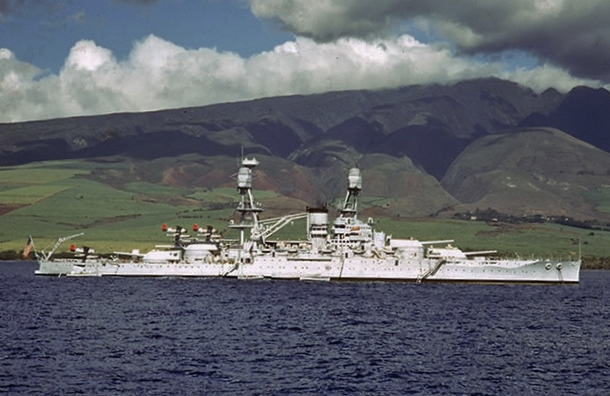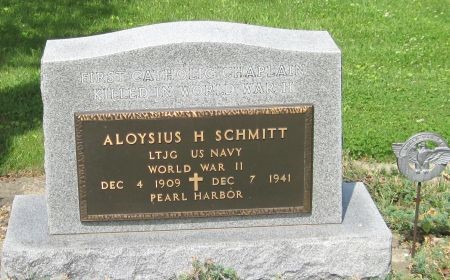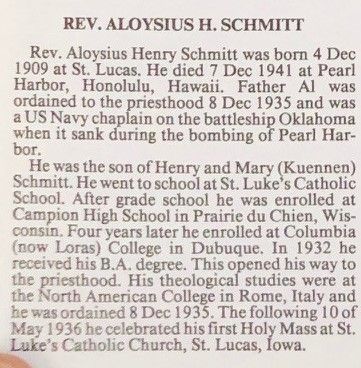Aloysius Herman Schmitt was born in St. Lucas, Iowa, on December 4, 1909, the son of Henry and Mary Anna (Kuennen) Schmitt. He studied at Columbia College (now Loras College) in Dubuque, Iowa, and graduated in 1932. He studied for the priesthood in Rome and was ordained on December 8, 1935, by Italian Cardinal Francesco Marchetti Salvagnini. He returned to the United States in 1936 and was assigned as Associate Pastor to Saint Mary Church in Dubuque. He was also assigned to St. Mary Cathedral in Cheyenne, Wyoming. After four years, he received permission to become a chaplain and joined the United States Navy. He was appointed Acting Chaplain with the rank of Lieutenant Junior Grade (LTJG) on June 28, 1939.
On December 7, 1941, he had just finished saying morning Mass when the USS Oklahoma, with about 1,300 sailors on board, was torpedoed by Japanese forces in 50 feet of water. The attack caused the ship to roll over on its side, trapping hundreds below deck. Instead of running to safety, Fr. Schmitt stayed to help pull survivors from the submerged bottom deck and was able to help 12 people escape through a porthole.
In 1942, the Navy initially posthumously honored him with a Navy and Marine Corps Medal and the Purple Heart. St. Francis Xavier Chapel at Camp Lejeune, a Marine Corps training facility in Jacksonville, North Carolina, was dedicated in his memory in 1942. A destroyer escort named USS Schmitt was commissioned in 1943 by the Navy in his honor and served until 1967, when it was transferred to Taiwan. In 1944, the Navy presented a specially made crucifix to the Archdiocese of Dubuque in his honor. It was 24 inches tall and made from the teakwood deck of the Oklahoma. The corpus of Christ on the crucifix was fashioned from the ship's metal. The presentation was made by the Chief of Chaplains, 8th Naval District. Christ the King Chapel at Loras College was dedicated in his memory in 1947 and contains Fr. Schmitt's personal effects recovered from the Oklahoma. Present at the dedication were Cardinal Samuel Stritch of Chicago and Admiral Chester Nimitz, commander of the Pacific Fleet during World War II. City Island, in the Mississippi River near Dubuque, was renamed Chaplain Schmitt Memorial Island.
Most of the bodies were recovered after the ship was righted in 1943. His remains were originally buried in a cemetery in Hawaii as an "Unknown." In 2015, the United States Department of Defense exhumed the remains of 388 military personnel. Schmitt's remains were identified in 2016 from DNA taken from his skull and matched with that of a relative. They were returned to Iowa where a Memorial Mass was celebrated in his home parish of St. Luke in St. Lucas, Iowa, on October 5, 2016. His remains were then transferred to Dubuque, where a funeral Mass and burial were held in Christ the King Chapel at Loras College on October 8, 2016.
The United States military determined that Fr. Schmitt merited the Silver Star, the 3rd-highest combat decoration. The Silver Star citation reads: "The President of the United States of America takes pride in presenting the Silver Star (Posthumously) to Lieutenant Junior Grade (Chaplain) Aloysius Herman Schmitt, United States Navy, for heroism involving voluntary risk of life not involving conflict with an armed enemy, while serving as a Chaplain on board the USS Oklahoma, during the attack by Japanese forces at Pearl Harbor, Territory of Hawaii, on 7 December 1941. Chaplain Schmitt was aboard the USS Oklahoma when that vessel capsized and was entrapped in a compartment where only a small porthole provided outlet for escape. With unselfish disregard for his own plight, Chaplain Schmitt assisted his shipmates through the porthole. While his shipmates were in the process of rescuing him, his body became wedged in the narrow opening. Realizing that other men had come into the compartment looking for a way out, Chaplain Schmitt insisted that he be pushed back into the ship so that they might escape. Calmly urging them on with a pronouncement of his blessing, he remained behind while they crawled out to safety." The Chief Chaplain of the Navy presented the upgraded medal to his family at Loras College on December 7, 2017.
Information from Wikipedia; the December 1, 2017, issue of The Witness, the newspaper of the Archdiocese of Dubuque, Iowa; and ChurchMilitant.com. The last name of the ordaining Cardinal from the December 1941 Ashton Herald, Ashton, Nebraska, submitted by Diane, Member #47528261. Combined, edited, and submitted by Angela, Member #48520699.
Aloysius Herman Schmitt was born in St. Lucas, Iowa, on December 4, 1909, the son of Henry and Mary Anna (Kuennen) Schmitt. He studied at Columbia College (now Loras College) in Dubuque, Iowa, and graduated in 1932. He studied for the priesthood in Rome and was ordained on December 8, 1935, by Italian Cardinal Francesco Marchetti Salvagnini. He returned to the United States in 1936 and was assigned as Associate Pastor to Saint Mary Church in Dubuque. He was also assigned to St. Mary Cathedral in Cheyenne, Wyoming. After four years, he received permission to become a chaplain and joined the United States Navy. He was appointed Acting Chaplain with the rank of Lieutenant Junior Grade (LTJG) on June 28, 1939.
On December 7, 1941, he had just finished saying morning Mass when the USS Oklahoma, with about 1,300 sailors on board, was torpedoed by Japanese forces in 50 feet of water. The attack caused the ship to roll over on its side, trapping hundreds below deck. Instead of running to safety, Fr. Schmitt stayed to help pull survivors from the submerged bottom deck and was able to help 12 people escape through a porthole.
In 1942, the Navy initially posthumously honored him with a Navy and Marine Corps Medal and the Purple Heart. St. Francis Xavier Chapel at Camp Lejeune, a Marine Corps training facility in Jacksonville, North Carolina, was dedicated in his memory in 1942. A destroyer escort named USS Schmitt was commissioned in 1943 by the Navy in his honor and served until 1967, when it was transferred to Taiwan. In 1944, the Navy presented a specially made crucifix to the Archdiocese of Dubuque in his honor. It was 24 inches tall and made from the teakwood deck of the Oklahoma. The corpus of Christ on the crucifix was fashioned from the ship's metal. The presentation was made by the Chief of Chaplains, 8th Naval District. Christ the King Chapel at Loras College was dedicated in his memory in 1947 and contains Fr. Schmitt's personal effects recovered from the Oklahoma. Present at the dedication were Cardinal Samuel Stritch of Chicago and Admiral Chester Nimitz, commander of the Pacific Fleet during World War II. City Island, in the Mississippi River near Dubuque, was renamed Chaplain Schmitt Memorial Island.
Most of the bodies were recovered after the ship was righted in 1943. His remains were originally buried in a cemetery in Hawaii as an "Unknown." In 2015, the United States Department of Defense exhumed the remains of 388 military personnel. Schmitt's remains were identified in 2016 from DNA taken from his skull and matched with that of a relative. They were returned to Iowa where a Memorial Mass was celebrated in his home parish of St. Luke in St. Lucas, Iowa, on October 5, 2016. His remains were then transferred to Dubuque, where a funeral Mass and burial were held in Christ the King Chapel at Loras College on October 8, 2016.
The United States military determined that Fr. Schmitt merited the Silver Star, the 3rd-highest combat decoration. The Silver Star citation reads: "The President of the United States of America takes pride in presenting the Silver Star (Posthumously) to Lieutenant Junior Grade (Chaplain) Aloysius Herman Schmitt, United States Navy, for heroism involving voluntary risk of life not involving conflict with an armed enemy, while serving as a Chaplain on board the USS Oklahoma, during the attack by Japanese forces at Pearl Harbor, Territory of Hawaii, on 7 December 1941. Chaplain Schmitt was aboard the USS Oklahoma when that vessel capsized and was entrapped in a compartment where only a small porthole provided outlet for escape. With unselfish disregard for his own plight, Chaplain Schmitt assisted his shipmates through the porthole. While his shipmates were in the process of rescuing him, his body became wedged in the narrow opening. Realizing that other men had come into the compartment looking for a way out, Chaplain Schmitt insisted that he be pushed back into the ship so that they might escape. Calmly urging them on with a pronouncement of his blessing, he remained behind while they crawled out to safety." The Chief Chaplain of the Navy presented the upgraded medal to his family at Loras College on December 7, 2017.
Information from Wikipedia; the December 1, 2017, issue of The Witness, the newspaper of the Archdiocese of Dubuque, Iowa; and ChurchMilitant.com. The last name of the ordaining Cardinal from the December 1941 Ashton Herald, Ashton, Nebraska, submitted by Diane, Member #47528261. Combined, edited, and submitted by Angela, Member #48520699.
Family Members
-
Helen Schmitt
1893–1919
-
William Frank Schmitt
1896–1975
-
![]()
Nick Henry Schmitt
1897–1969
-
![]()
Theresa A Schmitt Sloan
1899–1974
-
![]()
Frances C Schmitt Hauber
1901–1993
-
![]()
Sr Germaine "Barbara" Schmitt
1902–2000
-
![]()
Matthias Frank "Mat" Schmitt
1904–1971
-
![]()
Bernard "Ben" Schmitt
1904–1926
-
![]()
Elizabeth Schmitt Buchheit
1907–1986
-
![]()
LTJG Aloysius H. Schmitt
1909–1941
-
![]()
Aloysius Herman Schmitt
1909–1941
















